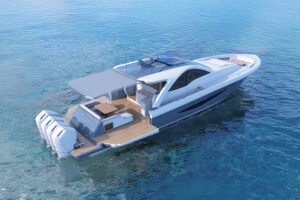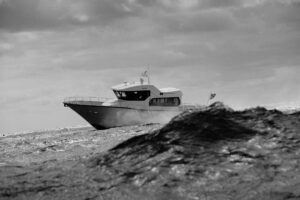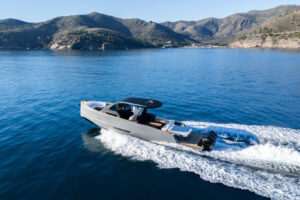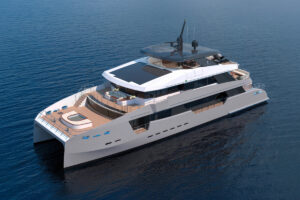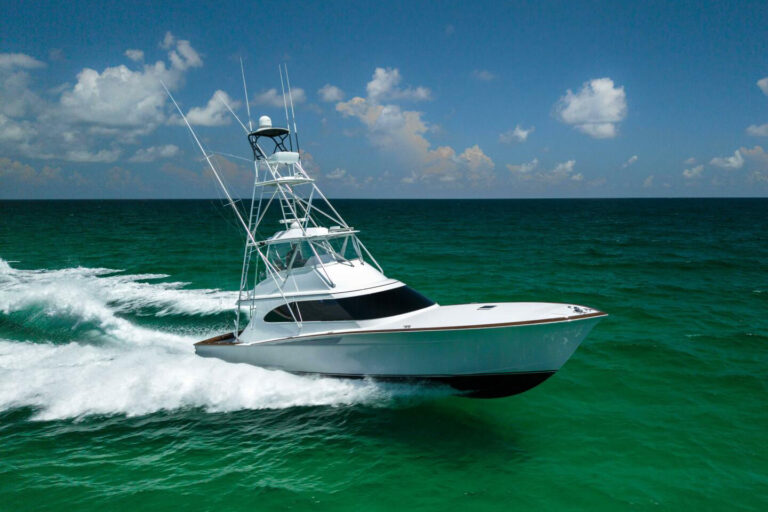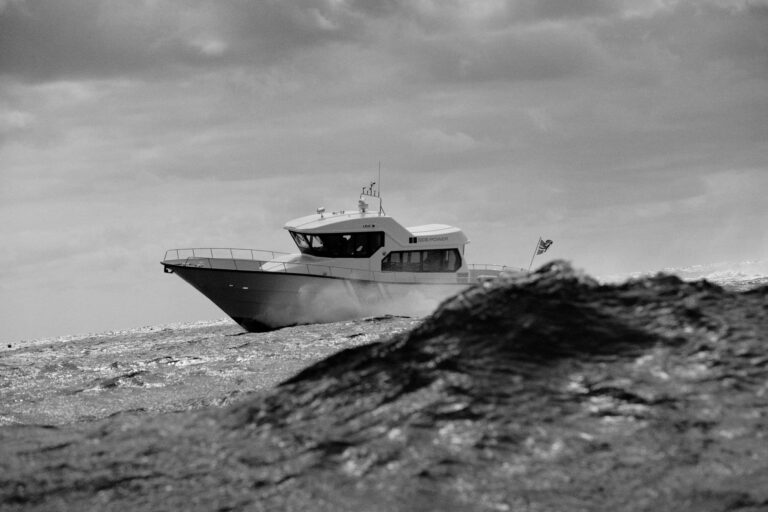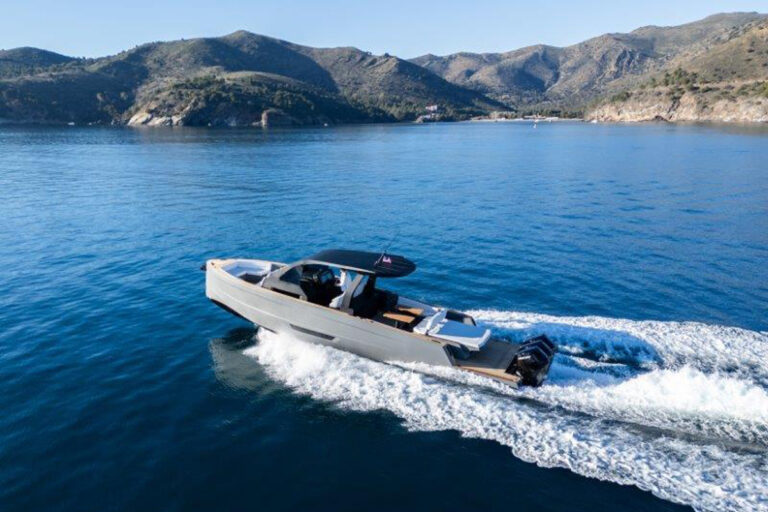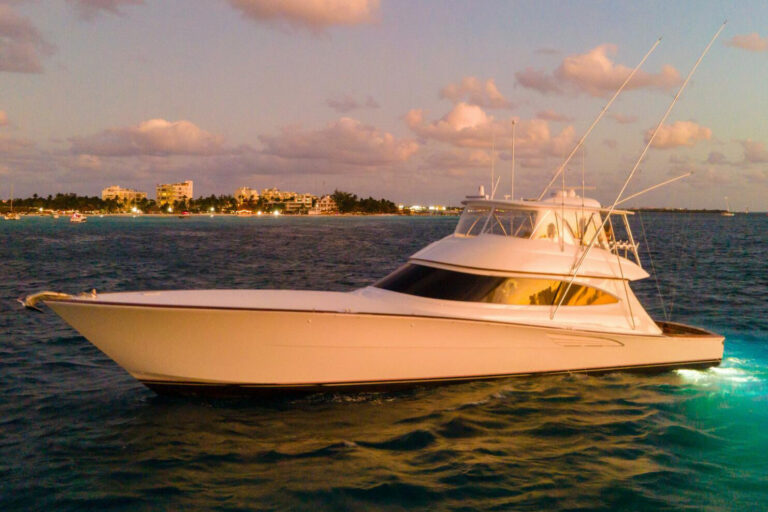

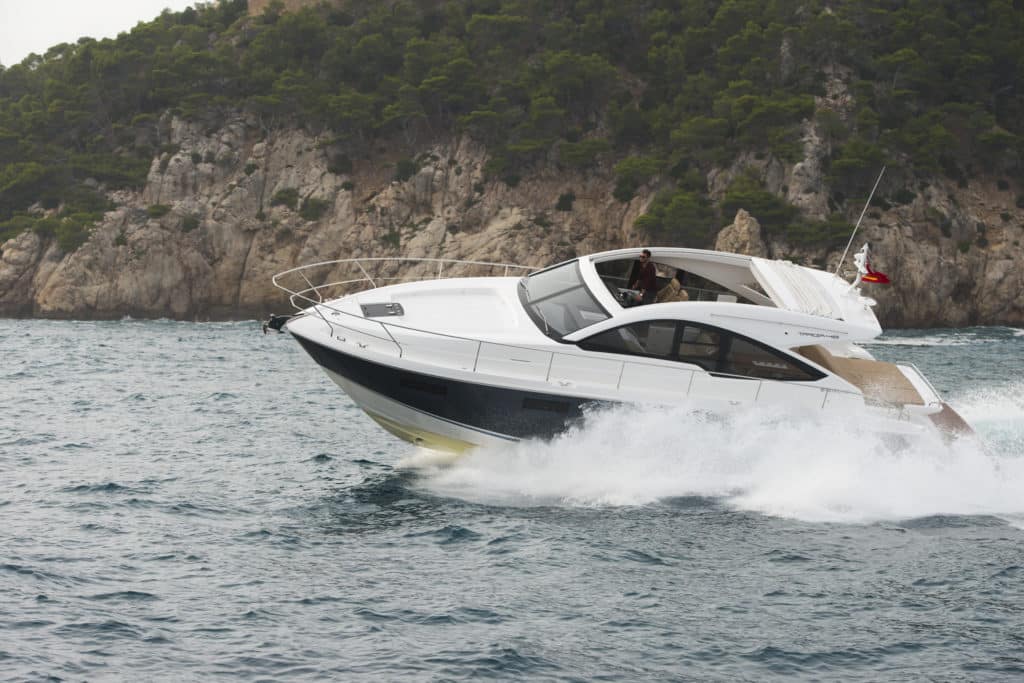








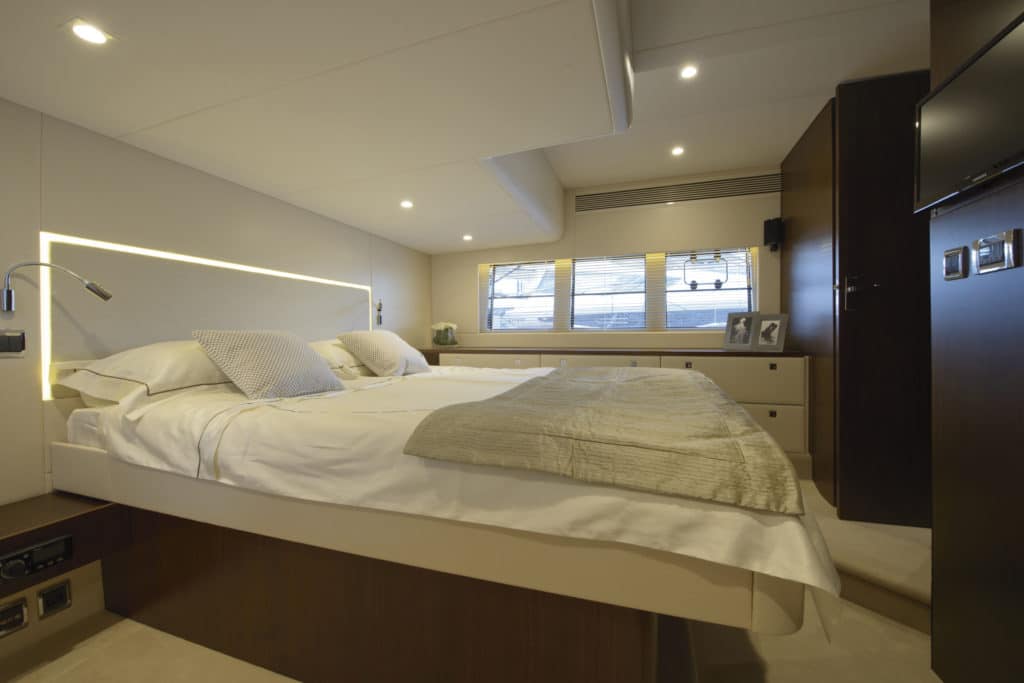






The designator open on most performance yachts refers to an unobstructed cockpit exposed to the elements.
For U.K. builder Fairline, however, the open in its Targa series carries a more flexible meaning: one that lets the owner choose between a full-sky experience or buttoned-down protection. Its Targa 48 Open has a hardtop that encloses the cockpit but is open at the after end.
A retractable centerpiece made of Sunbrella fabric comprises about 70 percent of the hardtop’s length and nearly all of its width when extended. With the centerpiece open, so is the cockpit, and the boat is transformed into an open-air cruiser. Closed, the area is dry and cozy.
The 48’s accordion soft top is just one of the advanced design features on what is a legitimate breakthrough boat for the builder. Facing strong competition from manufacturers in the U.K. and mainland Europe, Fairline decided several years ago to reinvent itself by investing $5.4 million in an advanced computer numerical control (CNC) facility for woodworking and lacquering, as well as tooling for its entry into building boats via vacuum infusion.
Its 48 series features three motoryacht styles: Open, Gran Turismo and Squadron. They all share the same hull design and were the builder’s first models to benefit from the initiative. The three 48s were also designed specifically for use with Volvo Penta’s IPS drive system.
What amounts to successfully completing a technical jigsaw puzzle (IPS design, vacuum infusion and a common hull) should give Fairline an edge in bringing new models to market. “We were able to complete the common-hull 48 project in 18 months,” says Andrew Pope, chief designer at Fairline. “The current Targa 50 took 15 months. So for an extra three months, we got two more boats.”
A number of builders use the common-hull modelfor boats under 25 feet, but it’s a rarity on larger models where weight distribution and center of buoyancy differ significantly. The Targa 48 Open, for instance, is 2,000 pounds lighter than the flybridge 48 Squadron, and of course there are buoyancy and windage differences with the Squadron’s higher profile.
That meant some compromises: Wider chines and a broader beam were designed into the 48 Open to ensure the stability of the more top-heavy Squadron. According to the builder, “the trick was to create three models with similar physical characteristics, such that the performance of all three models was suitable for the intended market. The individual design details of the hull all work in harmony to provide the best overall solution, resulting in one of the best-performing IPS boats on the market.”
My first impression of the 48 Open dockside was that she looks even better in person than her earlier images suggested. Hull No. 2 had what Fairline calls steel blue sides rather than the prototype’s gray hull. She also features a distinctive swept-back hardtop and flowing, porpoise-shaped side windows.
My second impression was that she is a fun and predictable boat to drive. The seas in the Golfe de la Napoule outside Cannes, France, were 1 to 2 feet, and she delivered a smooth ride. Her twin 435 hp Volvo Penta diesels lifted her 28,660 pounds on plane in about 15 seconds, and my test vessel reached an average top end of 29.5 knots. The hull tracked well, doing 180-degree turns in three boat lengths.
Fairline says the 48 will reach 33.6 knots at 3,622 rpm with different props, and the GPS numbers I ran tracked with the builder’s data until mine stopped just shy of 30 knots at 3,350 rpm. The boat also had an 880-pound Williams 285 jet tender in the garage, which likely knocked off some potential top-end speed.
One of the benefits of IPS is that fuel efficiency improves as engine rpm increases. When the diesels hit 2,400 rpm, according to Fairline (fuel-flow data was not available on my test 48), the boat will do 15.8 knots with a fuel consumption of 20.7 gph and a range of about 211 nm. Bump the motors up to 3,000 rpm, and the 48’s speed increases to 24.6 knots and fuel consumption reportedly increases to 32.2 gph, offering a range of about 212 nm. Even at the 33.6-knot top end, the 48 is said to deliver a range of 209 nm.
It took me a little time to get accustomed to the helm setup because you drive from the left-hand seat while the companion sits on the right. The left-center position of the helm makes sense for being able to see both sides for docking, but it felt odd having the Garmin 7000 series plotter/radar display on the right and throttles in the center.
The form-fitting Recaro bucket-style helm seats were probably the best I’ve ever used. Fairline had the Dutch manufacturer build the two seats to its specs, shortening the seat base while using simulated leather and stitching them for a custom look. The seats had the Targa name stitched into the center, adding a touch of class to the helm area. Ditto for the teak footrest under the steering wheel. The optional teak cockpit and side decks dressed up the exterior well too.
There was a nice sense of proportion across the cockpit, a Goldilocks factor where all areas felt just right. The U-shaped lounge (7 feet 6 inches by 7 feet 9 inches by 7 feet 6 inches) found amidships with its teak table is good for a group of six diners. But the really cool thing is that the table is attached by a single leg to the lounge, rather than the deck, and it folds into the lounge without disassembly. The cockpit wet bar had an optional cabinet with an Isotherm fridge and ice maker to reduce trips to the galley.

From the dock, the three-person transom sun bed looked like overkill at more than 6 feet across and more than 6 feet in length. But in the cockpit it looked fine, especially on a boat designed for places like south Florida and the Bahamas. I sat on the sun bed when we were zipping around the bay, and the area was as dry as a proverbial bone. And I’m glad to report that the cockpit felt open and windblown with the Sunbrella toppulled all the way back.

Fairline modified the traditional IPS setup, Pope says, to enhance the 48’s handling. “We decoupled the drives from the engines, moved them forward and added a 3-foot-long shaft,” he says. “Moving the engines pushes the center of gravity forward, so it drives more like a shaft boat now. But we still gain the benefits of an IPS boat.”
Beyond improved performance, lower engine noise and a more compact engine compartment, the main benefit to the owner is a greatly enlarged (see: full-beam) master stateroom. With a max headroom of 6 feet 7 inches and opposing banks of hull-side windows, her master is impressive for a 48-foot boat. “We tripled the size of the windows from previous models,” Pope says.
This space also has white bulkheads to enhance the light feeling. Eight-foot-wide dressers along both sides offer plenty of stowage, and touches like leather-wrapped handles add a sense of luxury. The en suite head also has contemporary features like a square Italian porcelain sink and large shower.
Fairline’s recently adopted resin-infusion process added interior volume because the stronger, lighter hull uses a lower-profile tray system to hold bulkheads in place, compared with the taller, bulkier stringer system of a hand-laid hull. The builder’s CNC machinery also cuts bulkheads and other internal parts to tighter tolerances. That combination of lighter weight, precision and strength adds up to more usable volume.
In addition to the technological advances, Fairline’s fit and finish remain at their traditionally high level. There were no mismatched grains on the interior walnut bulkheads, and the quality of finish on the white-oak soles was impeccable. One of Fairline’s European competitors told me without prompting that it’s aiming for “Fairline standards” when it comes to interior joinery. In addition to walnut and white oak, Fairline also offers brushed white oak and a chocolate oak sole. Dozens of options including carpet colors, blinds, countertop materials, furniture fabrics and soft goods allow an owner to personalize his 48.
Fairline is touting the Targa 48 Open’s multifunctional cockpit, but her well-conceived interior is just as important to the overall cruising experience, giving this newest Fairline a depth that redefines the open concept. Your hardest decision will be whether to run her with the top open or closed. It’s nice to have options.
Fairline, +44 183 227 3661; fairline.com/en
| Specifications | Manufacturer Supplied Numbers |
|---|---|
| Length overall with fixed platform | 50ft 9in (15.46m) |
| Length overall with hi-lo platform | 48ft 6in (14.79m) |
| Length overall with fixed platform | 49ft 2in (15.0m) |
| Beam | 14ft 2in (4.32m) |
| Number of berths | 4-7 |
| Draught unloaded | 3ft 10in (1.18m) |
| Height above waterline | 15ft 1in (4.6m) |
| Transport height | 15ft 10in (4.83m) |
| Dry weight | 12.79 tons (13,000kg) |
| Fuel capacity | 288 gals/346 US gals (1,308L) |
| Water capacity | 106 gals/127 US gals (480L) |
| Engines and Performance | 2 x Volvo Penta IPS600 D6-435 Diesel 435 – 32 knots |

